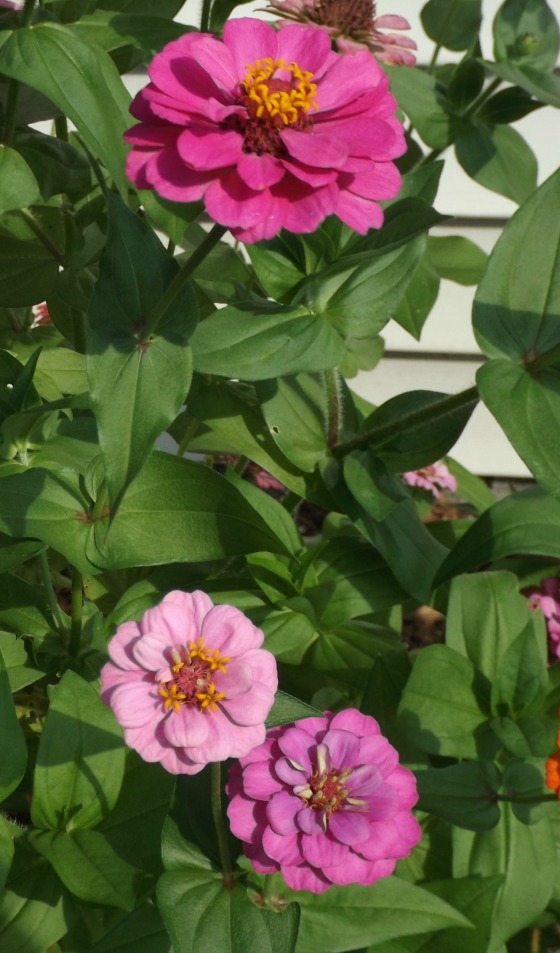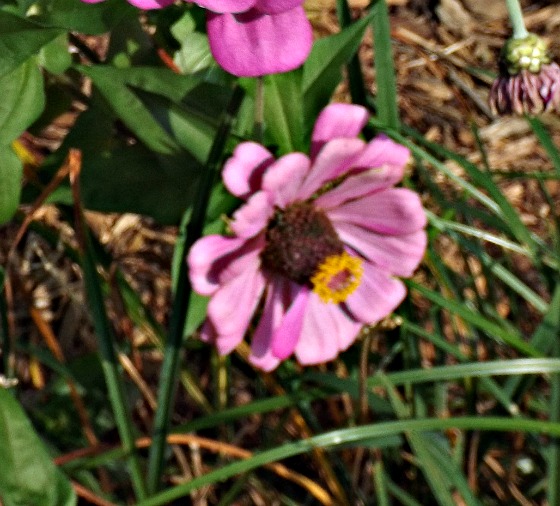When it comes to getting the most bang for your buck, a zinnia plant cannot be beat. Adding a big splash of color to your landscape will only run you $1.00 for a pack of seeds.
Zinnia plants (Zinnia elegans) are native to Central America, Mexico and the Southwestern United States, but they will easily grow in zones 2-11. In no-frost areas, the plants will grow as a perennial. In cold areas, it will reseed itself each year…making your $1.00 go a long, long way.
All you have to do is buy a pack of seeds and plant them!
Zinnia are one of the easiest plants to grow from seed. Just plant them about 1/2″ deep and keep them moist until they sprout. The seeds can be sown indoors, but there is no need. I start mine outside in the early spring (paying no attention to the frost). They are the first to sprout every year.
I find it best to put your seeds directly in the ground or in the pot that you want them to grow in. Zinnia plants don’t particularly like to be moved, so its best not to transplant them unless you have to. Many people start them indoors. If you start your seeds in flats, transplant them when they are about an inch tall. Try to disturb the roots as little as possible when transplanting.
Plant them in full sun and watch them grow. Oh baby are they fast growers! The leaves fill out quickly. The average Zinnia will grow about 2.5- 3 ft tall. Some dwarf varieties will stay around 1 ft and taller varieties can grow over 6 ft. Plant them 8-12 inches apart. (If you sow them directly in the ground, thin them out.) Zinnia plants can be susceptible to powdery mildew in hot, humid areas. Be sure to space them out so they get plenty of air flow.
You can expect blooms mid summer that will last into the fall. Zinnia plants are heavy bloomers. Colors can range from pink, orange, yellow, white, purple and every variation in between. Petals can be single layered, cone shaped or fringed.
The long lasting blooms make great cut flower arrangements. When cutting a flower stem, make your cut just above a node to encourage new blooms. Dead head the spent flowers to encourage new flower growth as well. When I deadhead, I toss my spent blooms to the base of the plant to provide seed for the next season’s growth. Zinnias are heavy bloomers. There will be plenty of spent flower heads to collect seeds from to give to friends or plant in other areas of your garden if you wish.
To collect seeds, simply split open the cone-shaped center of the flower head and collect the seeds from inside. There are easily over 100 seeds per flower. Not every seed will grow, but you’ll have plenty to work with. I’ll post a video below the blog about how to save the seeds.
Zinnia plants have no major insect problems. The showy flowers attract bees, butterflies and birds. I planted some outside my dining room window and noticed several humming birds hanging around. Zinnia are also deer resistant plants.
Check out this video on collecting Zinnia seeds:




Mr Mike, I’m in west GA in transition zone 7b and 8. I bought pounds of zinnia seeds of many varieties to direct sow. I’m wondering 2 things, can I sow seeds in late winter or should I wait until March 20th? Secondly, will the zinnias self sow and I will help with the sowing, seeds laying on the ground through the winter and grow new plants when the weather says go for it? Thanks Mr Mike!
Jeff,
I’d sow them now in milk jugs, research winter sowing, lots of great ideas on that but I don’t have a post about it.
have sown seeds but nothing came up i think it was to cold here in abbotsford bc so bought another pack of seeds nothing yet either what shoud i do
What I really want to know is how to grow giant sunflowers, or how to establish the ideal conditions. I’ve had mixed success. Sunflowers make me happy…..they make everyone happy when they smile at us 😉
Brad,
I have to think that sunflowers should be pretty easy. Good, rich soil that is well drained is all they would need I would think. Of course they are prolific growers so some fertilization, but not too much will help. I’d pretty much treat them like I would corn.
The “collecting zinnias video” heroine can collect them at my house 😉 , but seriously, the plants self-seed every year where I live and I attribute it to a southerly facing exposure that is well mulched. Every year, mid summer, the location explodes with color.
What zone are you in Mr Brad? I’m in 7b transition to 8 in west GA. I’m curious if I can direct sow in late winter and will they self seed and new plants the following spring.
Mike: what about planting in a pot to add some color … when it comes to a green thumb, I can’t even grow a cactus!
Can I plant now the seed? I am in Ohio weather. Still cold and quite often raining..
Matt,
Planting seed outside when it’s cold and rainy is never a good thing. The seeds can rot before they have a chance to germinate.
I have a small roadside stand for selling cut flowers. Zinnias are my second-best seller (after dahlias). For anyone who likes cut flowers, grow zinnias, They’ll easily last 10 days to 3 weeks. Just keep water in the vase. Even better, change the water every 2 or 3 days to keep it fresh. I did a small arrangement with a sprig of evergreen, a single stem (spray) of white mums and three red zinnias that’s now 24 days old and just starting to look tattered. Looks like Christmas in Oct.
It seems powdery mildew is most likely to take hold if the weather is unusually dry and the plants start to wilt from lack of water. (Same for phlox.) The solution — don’t let zinnias get stressed from lack of water. It may also help to plant zinnias in a different spot every year, rotating position over a three or four year period before returning to the original spot in your garden. GREAT FLOWER. Thanks for tooting zinnias’ horn, Mike!
If you will pinch out the top 2 leaves when they have put on 4 leaves, the zinnias will spread out and they will bloom from ground to top.